Real Sociedad are a footballing anomaly.
Nowhere else in Europe will you find a team in the upper echelons of the league table, with such a lacklustre goalscoring record.
La Real, who have secured Europa League football for the third consecutive season, spent the majority of the year floundering in front of goal. They go into the last game of the season with just 39 scored.
How have they overachieved so significantly?
The answer lies in one of La Liga’s most mature tactical setups, deployed by their bordering-obsessive coach, Imanol Alguacil.
Today we’ll dive into a tactical analysis of his philosophy, and understand why failing to score hasn’t held his team back from clinching European football.
Defending with the ball
You might have guessed that despite their offensive woes, Real Sociedad have built their season on a solid defensive structure. This scout report will reveal why that’s only partly true.
While they’ve only lost nine games and conceded 35 goals, La Real are one of the more positive teams in the La Liga. They average 54% possession – the 6th best overall.
This is far from a stoic, combative side looking to grind out a 1-0 every week. Rather, it’s a team committed to the idea of control. Control the ball, control the tempo, and do everything possible to prevent the opponent from doing the same.
That philosophy starts with their build-up from the goalkeeper and spills over into every facet of their game. Let’s start the analysis from the bottom.
Real Sociedad build-up
Like most modern, possession-based sides, Real Sociedad buildup from defence with strict, positional approach. Players occupy preset positions, creating the angles and distances to 1) stretch the opponent’s defensive shape and 2) progress the ball with control.
In the 21/22 season, La Real have played either a 4-3-3 or 4-4-2 diamond, and both tactics work the same way:
- The centre backs split
- The full backs pull wide on both sides
- The defensive midfielder occupies the space in between the opponent’s midfield and attack
- The interiors (attacking midfielders) also pull wide, to stretch the opposition midfield
It looks like this:
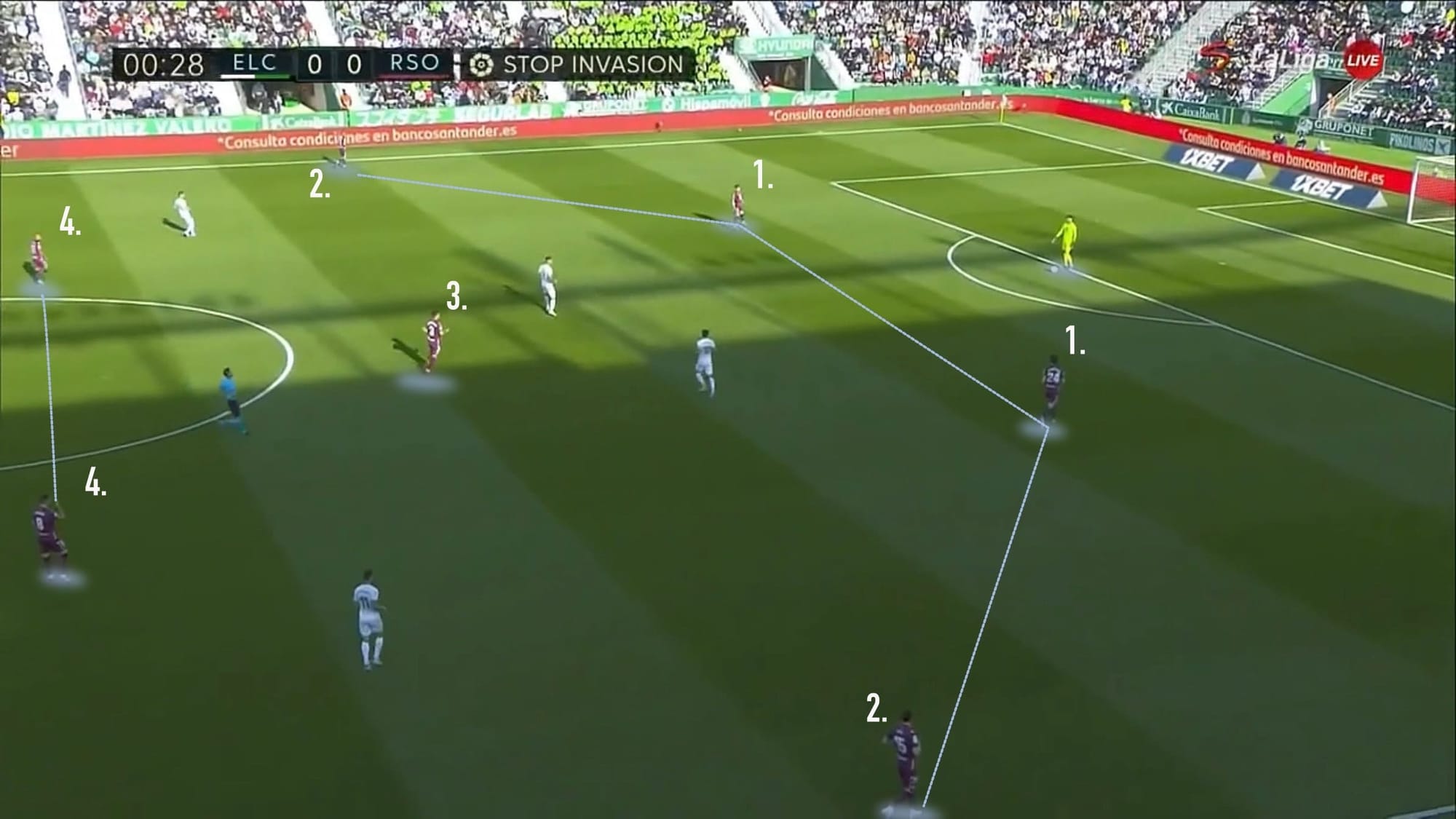
The key man is the defensive midfielder, in this case Martin Zubimendi (3).
With the opposition stretched, it’s Zubimendi’s job to find space, receive the ball, and progress it through the lines.
How he does this depends on the movement of the opponents. If he can, he’ll receive directly from the defenders, as in this example:
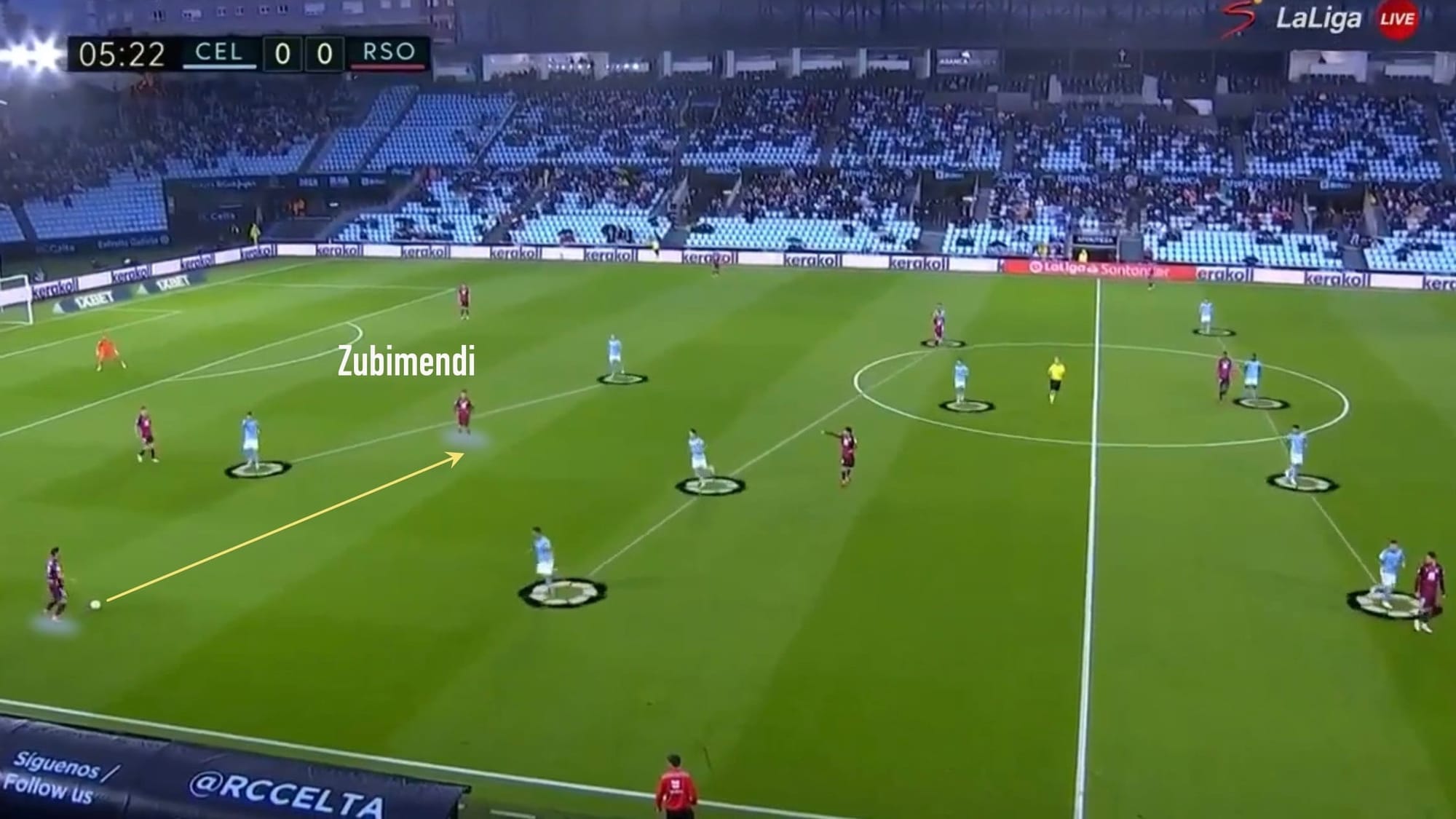
Or, if the passing lane is blocked, he’ll receive as a ‘third man’ from one of the interiors as below:
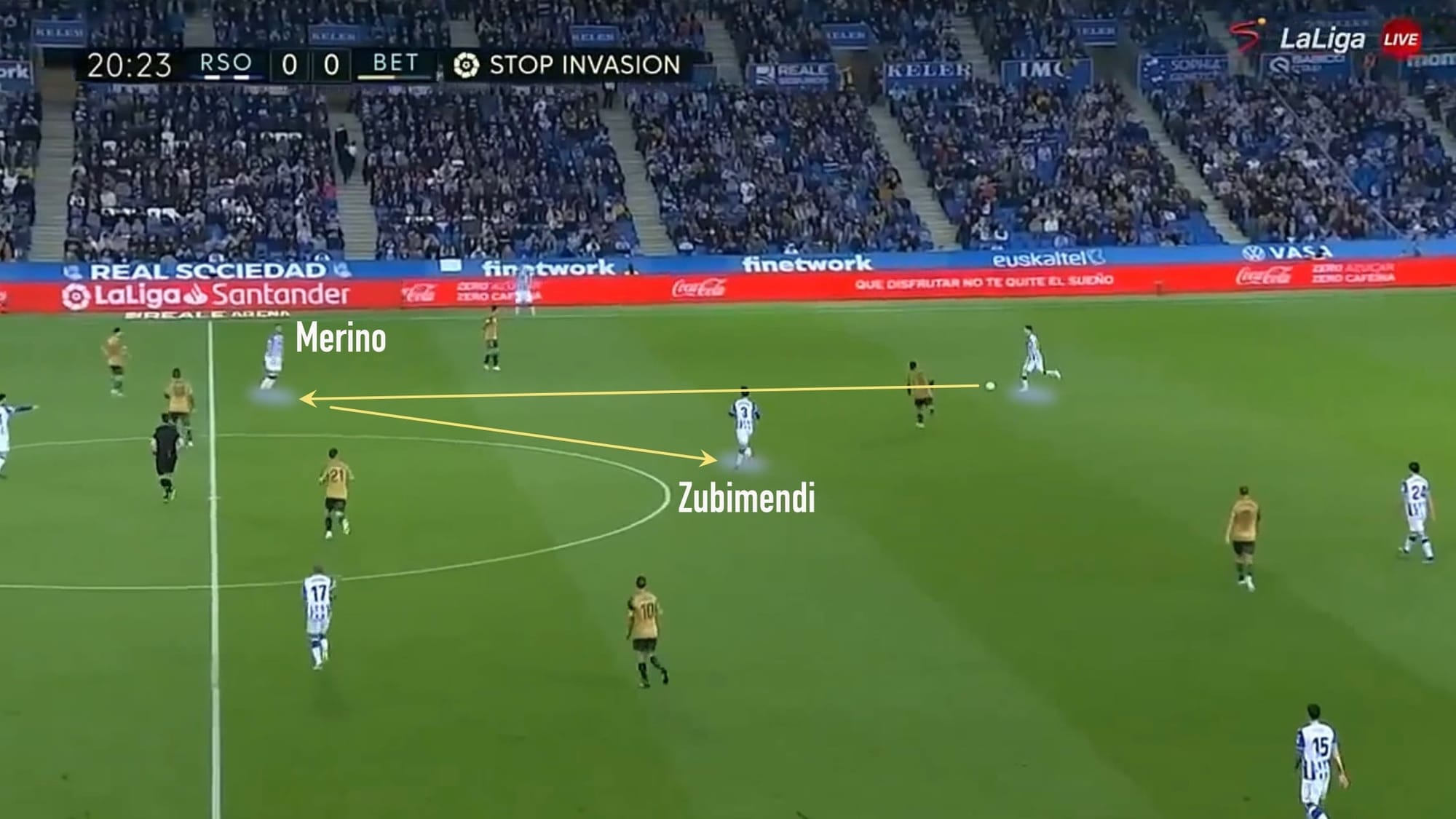
Real Sociedad are excellent at these patterns of play, and it makes them a very difficult team to press. They establish controlled possession often; a big reason for their healthy possession statistics. It also helps that they have a team brimming with ability and composure, and we’ll look more closely at that later on.
It’s okay to go long
There is an important caveat to this point: Real Sociedad prefer to build up from the back, but they are not obsessed with it. Under pressure, they will go long to the centre forward.
This is especially the case in the 4-4-2 diamond system, which usually deploys two centre forwards, Alexander Isak and Alexander Sørloth. The latter, the 6’4” Norwegian, is particularly good at holding the ball up and combining with the point of the diamond.
This option gives Real Sociedad a nice ‘get out of jail’ card if they fail to beat the press. They rarely get caught in these areas, or concede sloppy goals as a result.
Patience and counter-press
If they can break through the press, La Real tend not to go direct and look for the spaces immediately, but to establish possession in the middle third. It’s arguable that their hesitant tactics hinder their goal scoring. But as we’ll soon see, their approach isn’t just idealistic naïveté.
Once again, they have a very defined shape in possession. The defensive midfielder drops between the centre backs, allowing the full-backs to push even further forward, acting as wingers. If it’s 4-3-3, the winger will then push inside, one as a second striker and the other between the lines.
Meanwhile, one of the interiors (often Mikel Merino or Rafinha), drops deep and becomes the new single pivot. It essentially shifts to a 3-1-4-2, as you can see in the image below.
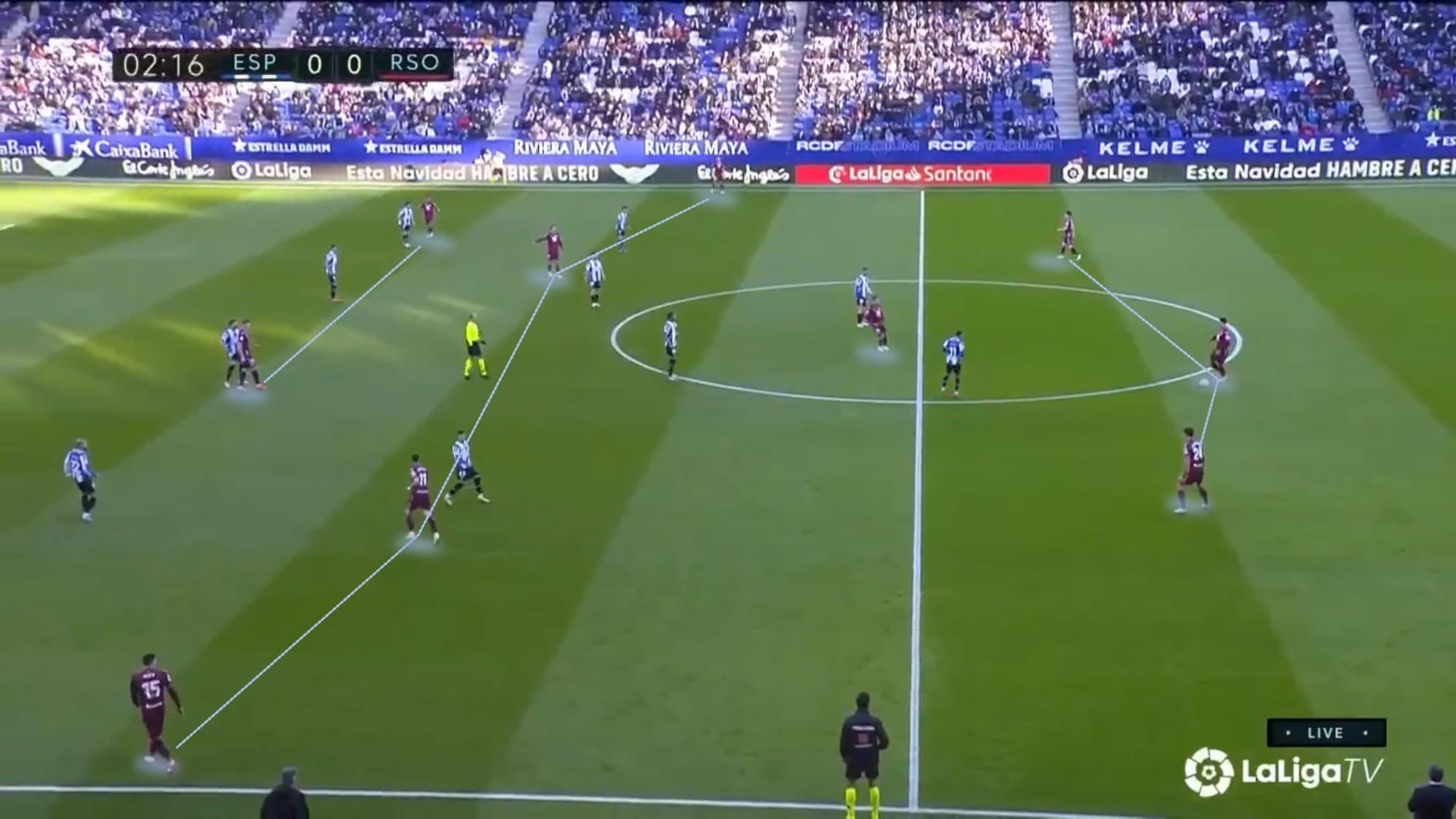
La Real are looking for one of two things:
- To play through the lines, with two ‘number 10s’ able to combine with two strikers
- If the middle is congested, to find their fullbacks in space and attack the box
In both cases, Real Sociedad concentrate their players in the centre of the pitch, with a lot of bodies in the vicinity of the ball when it’s played forward.
This is fundamental to why their defensive record is so good. La Real have one of the best counter-presses in La Liga.
The defensive midfielder is again the crucial instrument here. Stepping up from his ‘third centre back’ position, he is able to proactively read where the ball is breaking, and either win it back or jockey the man in possession, cutting out forward passes to prevent a quick counterattack.
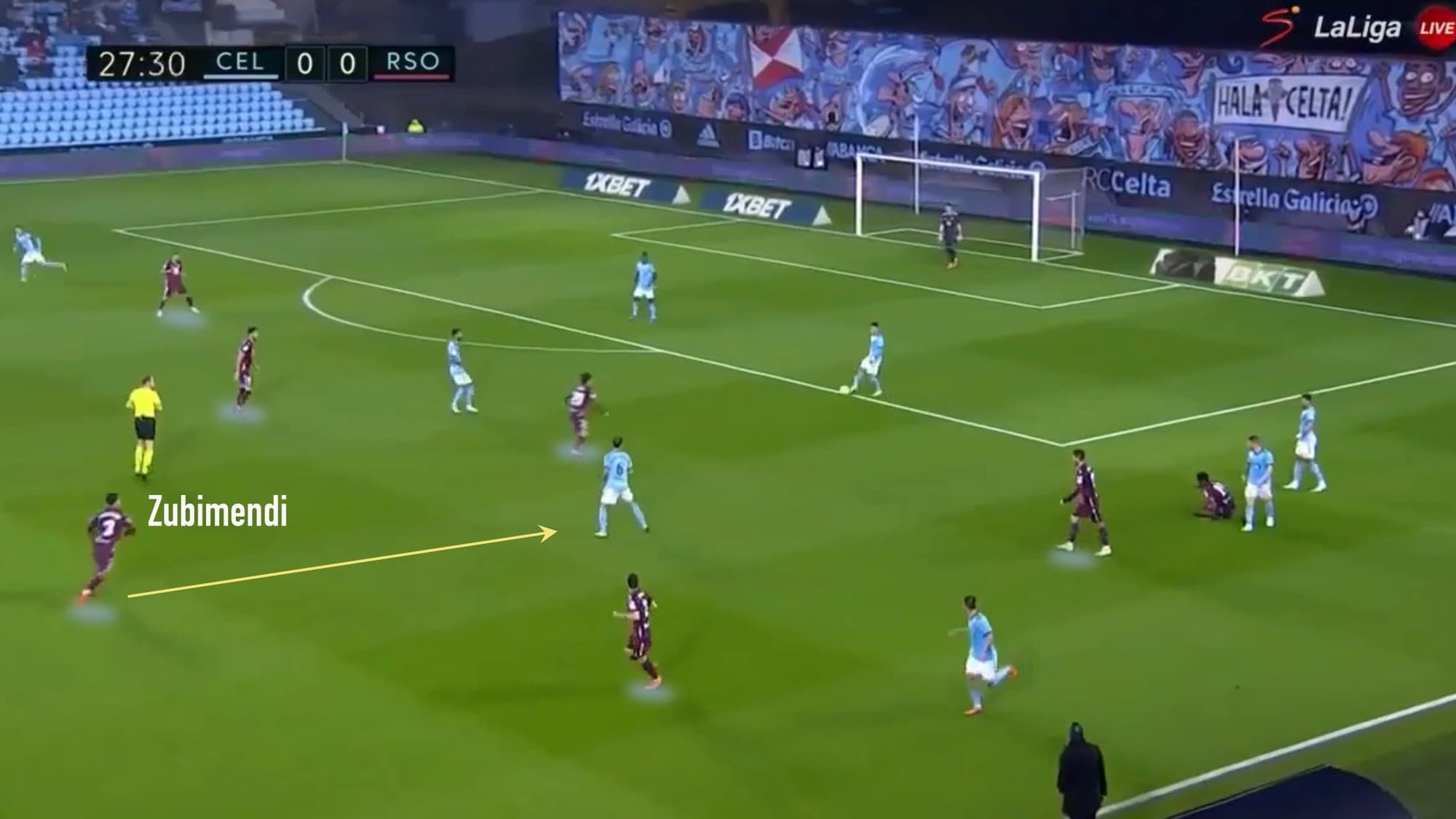
Considering how quickly the forward players swarm around the ball, it’s no surprise Real Sociedad win the ball back in the final third more than most other teams in the league. Only Barcelona, Real Betis and Celta Vigo do so more often.
Once Real Sociedad get a stranglehold on possession, it’s gruelling to play your way out of it.
Flexible, aggressive pressure
There’s a theme developing here. Patience and control in possession, but aggression and intensity out of it.
This is certainly the case with La Real’s defending, which, with the lack of goals, has become the bedrock of their successful campaign. They press high, with aggression, coordination and fluidity. The aim is simple: compact the space around the ball by flooding it with bodies. This is the case whether the ball is central, as below:
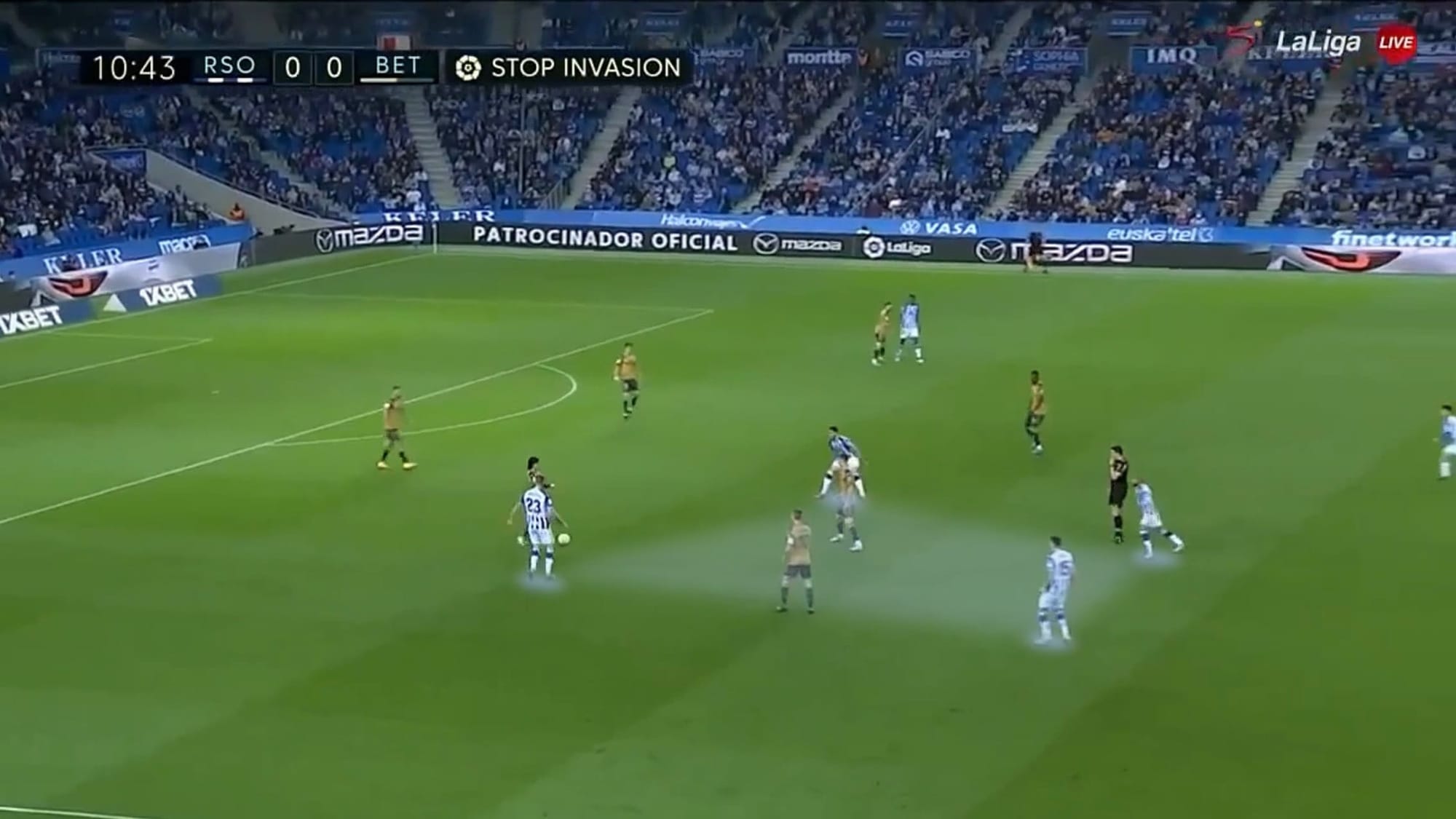
Or in a wide position, from a throw-in.
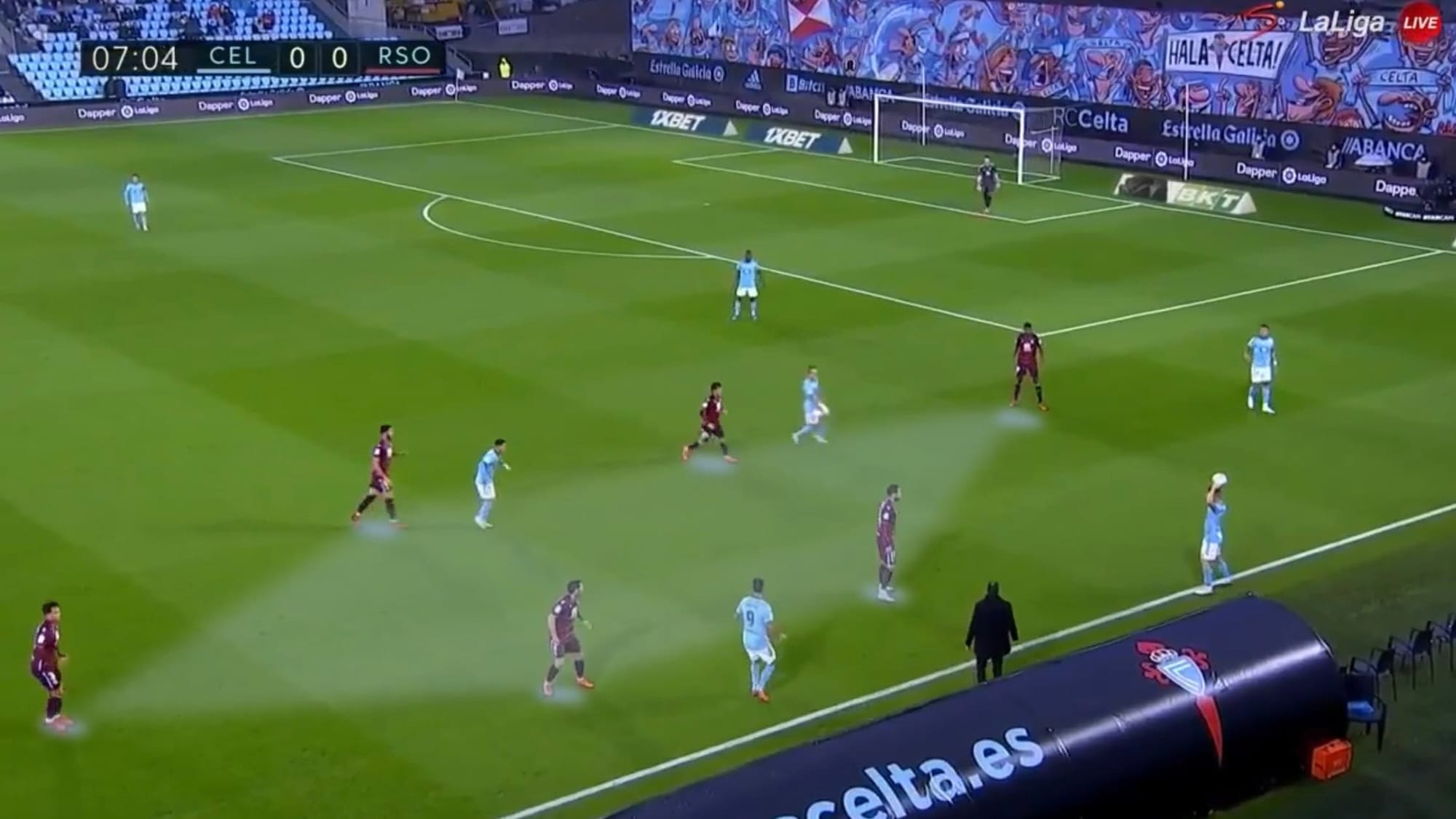
This is nothing revolutionary, of course, but effective. What’s more interesting is the way La Real adapt their press to suit different opponents.
This is credit to Imanol, and it’s partly why his system can be considered so well-developed. Here are two examples of their pressing shape, the first against Barcelona, and the second against Cádiz.
Against Barcelona, a side who are committed to building from the back, La Real pressed with all 10 players in Barcelona’s half, marking almost man-to-man. Both centre backs have pushed forward aggressively, and Zubimendi is deep in Barcelona’s half to prevent any space.
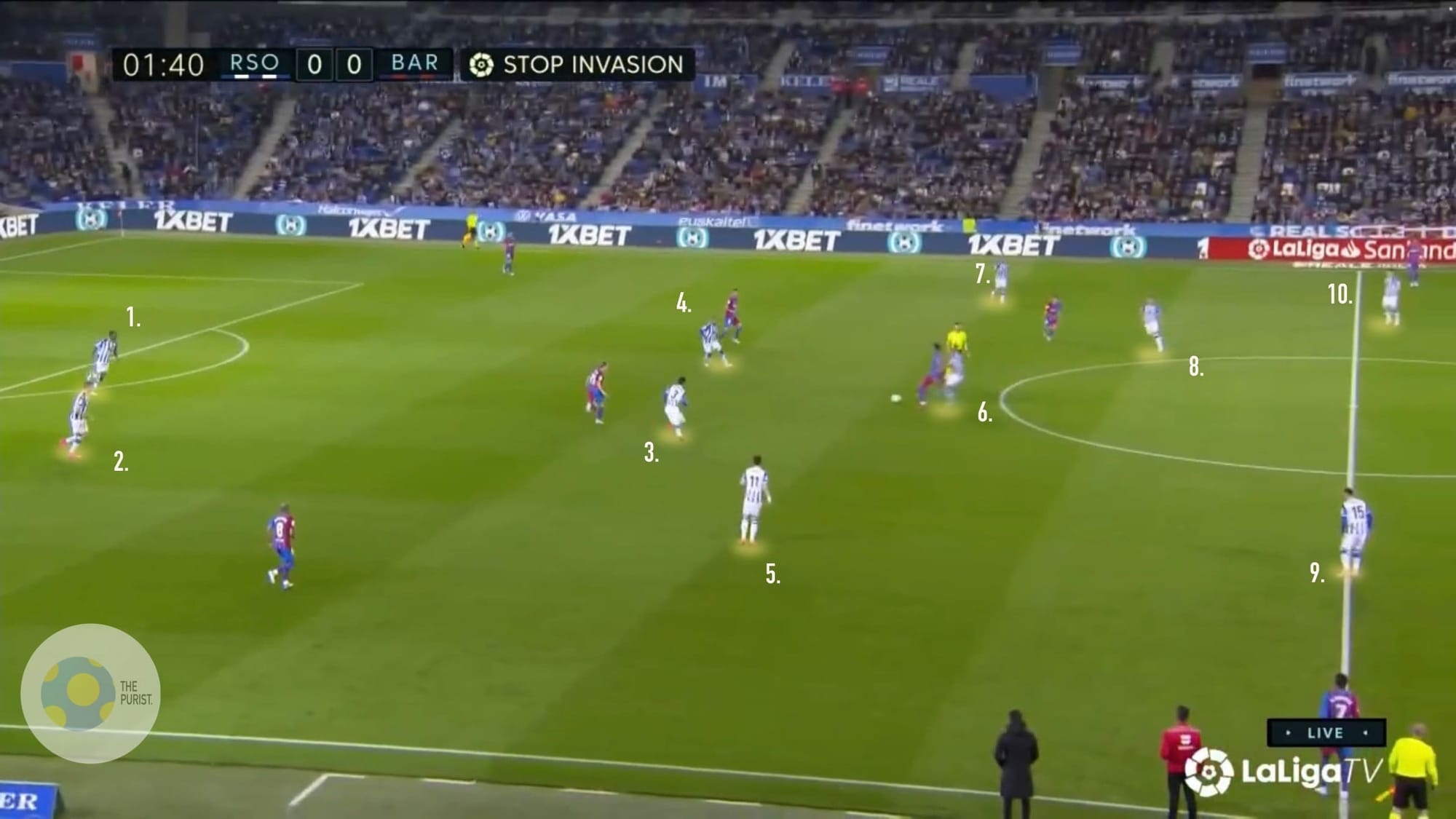
Despite losing the game, Real Sociedad really restricted Barcelona’s buildup. You can see from Barcelona’s heatmap how often the ball was stuck in the first third of the pitch (the red portions of the image represent more touches).
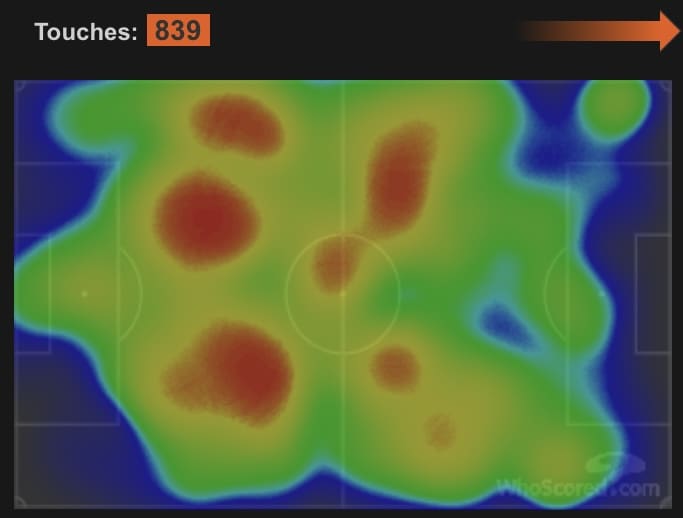
The next example shows a completely different approach, against relegation-struggling Cádiz. Here it’s a much more conservative press, as the defensive line drops off rather than marking tight.
With Cádiz far less likely to build up through midfield, the impetus shifts from preventing midfield combinations to defending against long balls. Zubimendi was stationed almost as a sweeper, to prevent any flick-ons and to create an extra man to win the second ball.
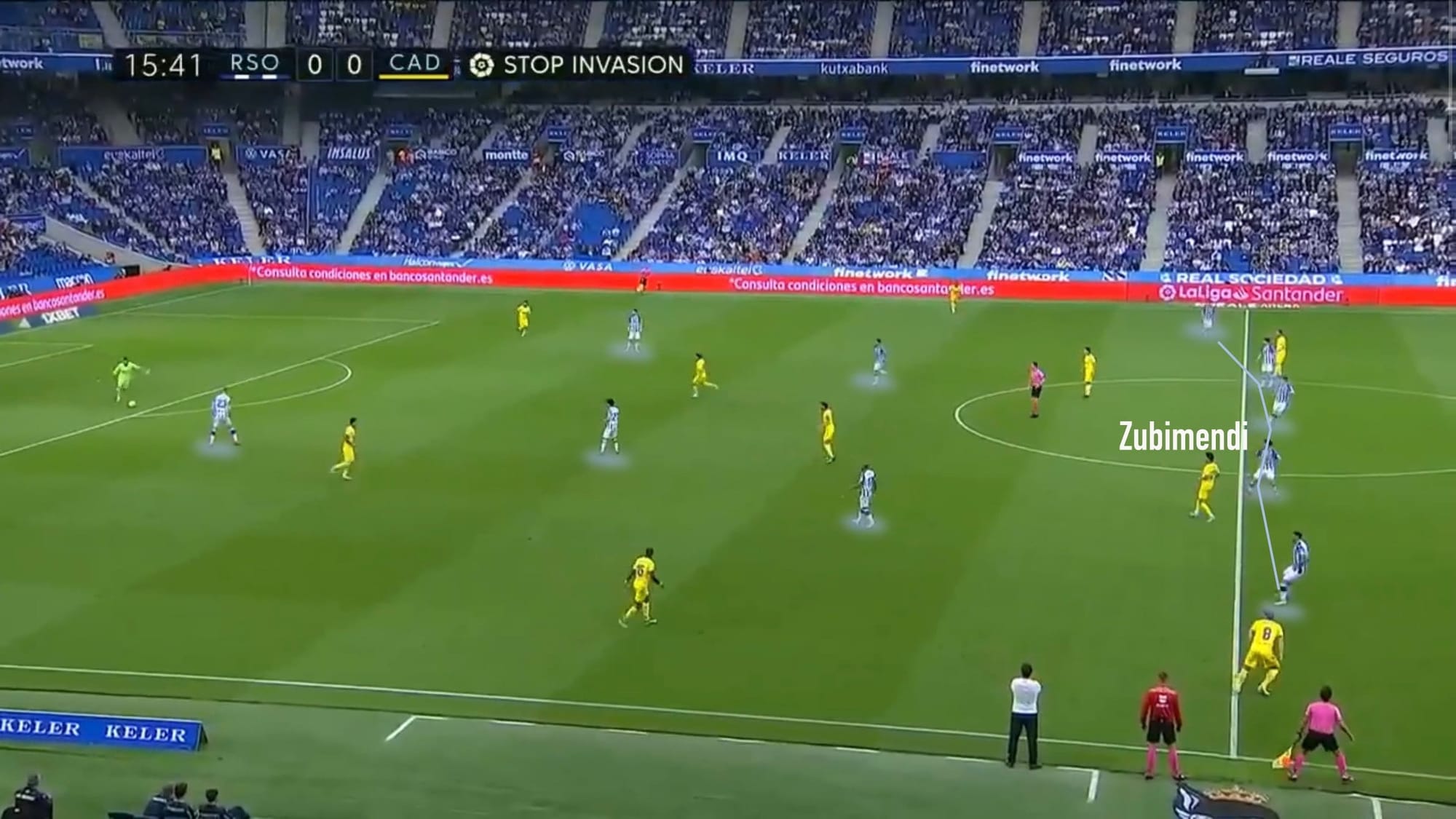
It’s this analysis and attention to detail from Imanol, who has been coaching his side for three years now, that makes him one of the league’s best tacticians.
Staying compact is an option
The beauty of Real Sociedad’s defensive structure is not always its broad tactical strokes, but its in-game flexibility. This is not a team obsessed with pressing for 90 minutes. Imanol has struck a nice balance between high pressure and establishing a compact shape out of possession.
Here you can see La Real settle into a compact 4-4-2, against one of the few teams better at keeping the ball: Celta Vigo.
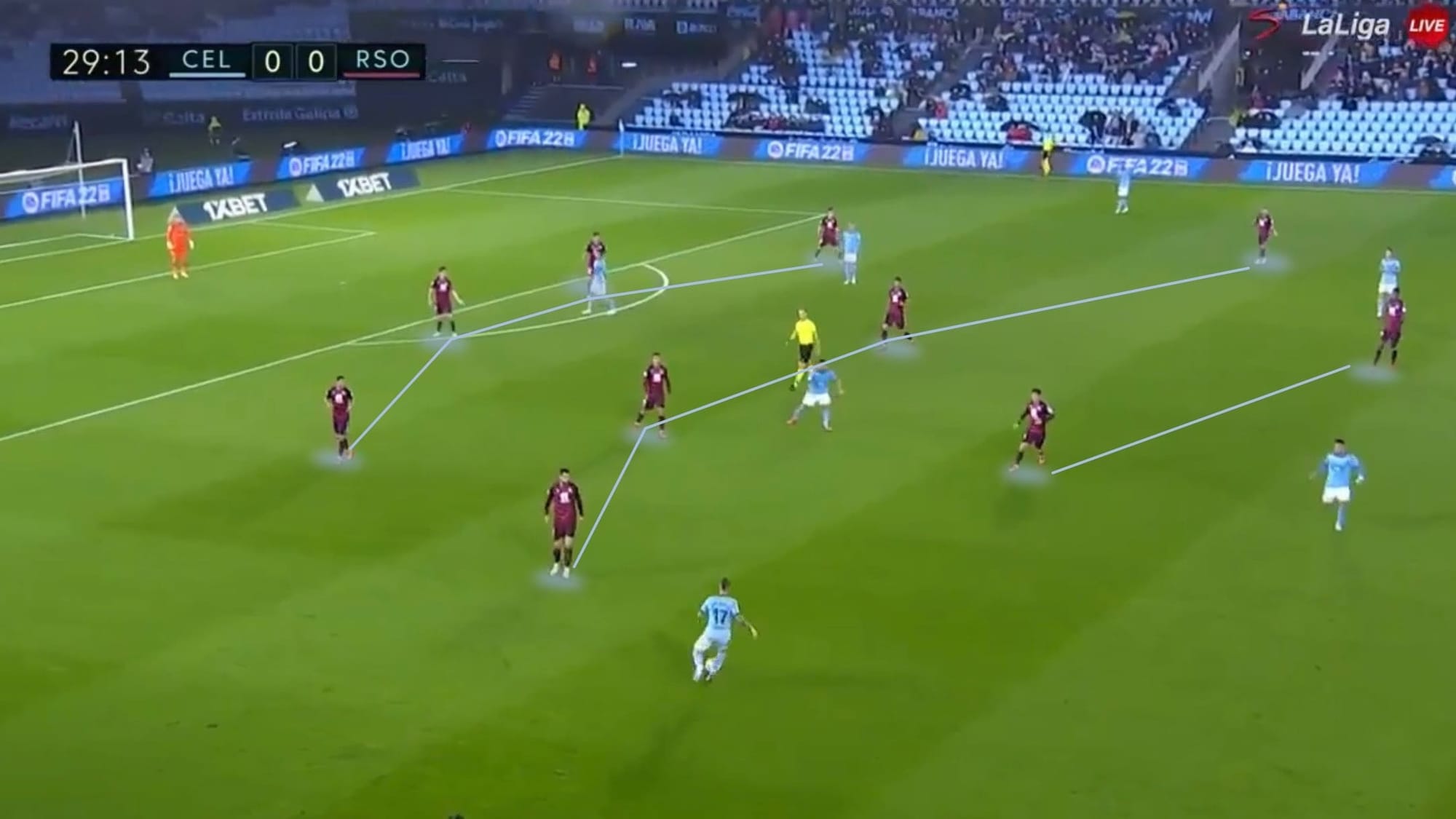
Despite racking up only 42% possession, La Real won the game 2-0. I hesitate to call the team pragmatic, as Imanol is clearly an idealist with a very consistent philosophy. But his team remains well-balanced nonetheless.
Key players
Behind the tactics board are the footballers tasked with executing all of this. It would be remiss not to talk about some of them in this final section. Particularly in the case of Real Sociedad, who have such a defined system that there are some really integral roles. Starting at the back.
Defence
The key man in defence this season for La Real has undoubtedly been Robin Le Normand. The French centre-back, now in his third season in the first team, has stepped up to be an essential part of Imanol’s side.
There are two defining characteristics that make him so important.
The first is his reliability on the ball. He’s a very capable ball-playing centre back, well-evidenced by his 89.8% average pass accuracy. Despite being a right-footed, left-sided centre back, he has a very good record at building from the back, maintaining 80% passing accuracy even when playing long balls forward.
But equally as important is his proficiency in aerial duels. Winning on average 3.95 aerials a game, he’s in the upper 91 percentile of all centre backs in Europe’s top five leagues. This is crucial for La Real, whose high press forces a lot of long balls from the opposition. With Le Normand on the other end, La Real are far more effective at keeping possession than they otherwise might be.
Of course, Le Normand is a centre back adept at most other aspects of the game. But this particular combination of attributes is priceless for any possession-based side. La Real have certainly profited from it.
Midfield
This is the area of the pitch where things get really interesting for Imanol’s side. There is effectively a specialist in every role, from David Silva’s deftness between the lines, to Zubimendi’s immense understanding of position and movement around him. But there are two other players I’d like to highlight in more detail here.
Like Le Normand, they are players who represent an important ying-yang for La Real: technique and defensive awareness. They are Mikel Merino and Rafinha.
Considering the team’s tight possession game, there are three fundamental attributes for these players: positional awareness, quality in tight spaces, and ball winning. In Merino and Rafinha, La Real have possibly the league’s most balanced midfielders outside of Barcelona and Real Madrid. Both are superb technicians, suited to La Real’s ball one-two touch passing game between the lines.
Here, for example, the two combine to create a shooting chance for Isak, despite working in minimal space.
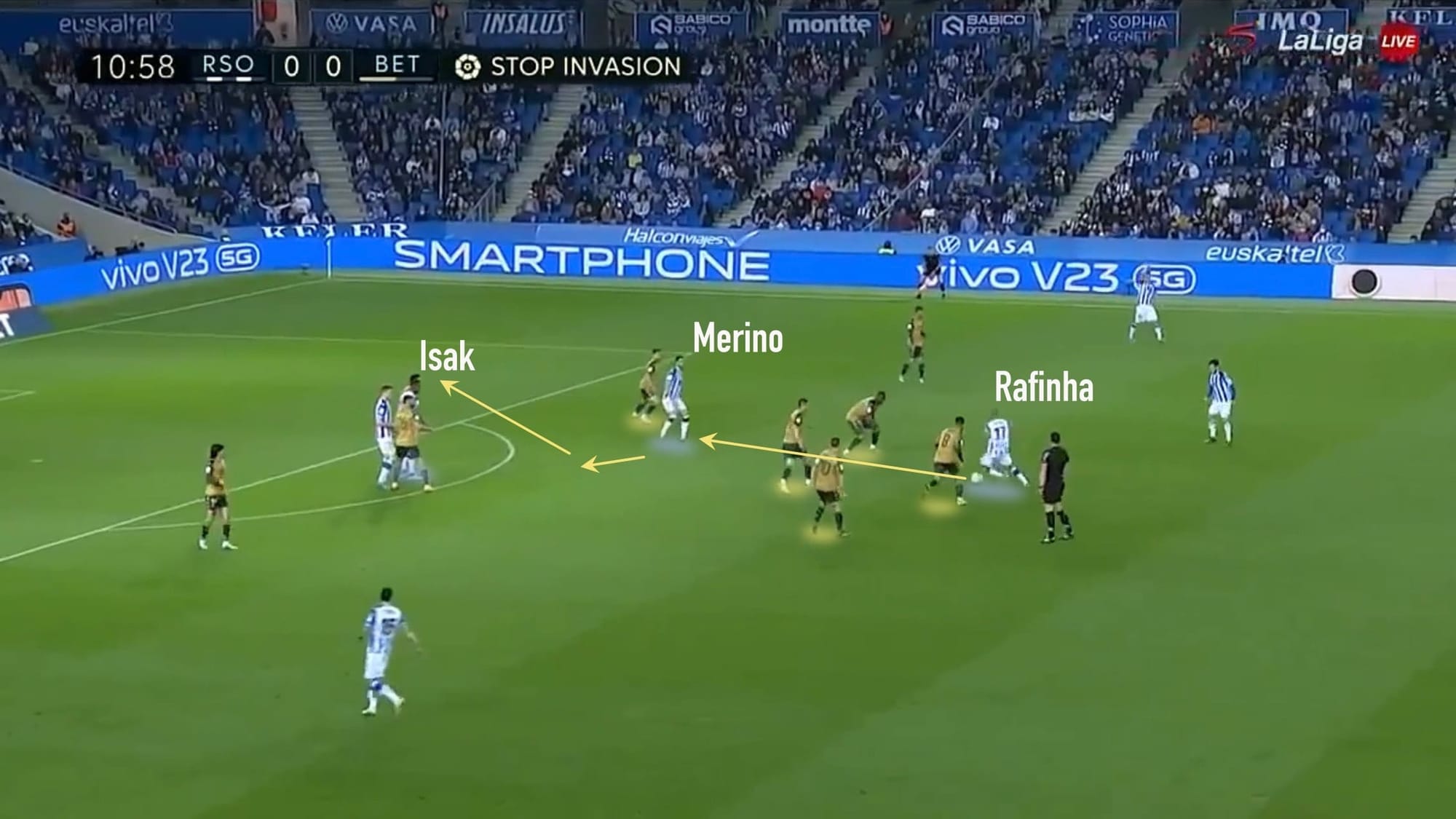
But as well as quality on the ball, they bring a lot out of possession. Merino is in the upper 98 percentile for midfielders for aerial duals won. While Rafinha is an immense ball winner for a player of his quality, statistically a more efficient tackler than Toni Kroos, Frenkie de Jong and Joan Jordán. Percentage-wise, he’s also more effective at applying pressure.
We’re talking about very adaptable midfielders here, who give Imanol almost exactly what he’s looking for. Control in possession, aggression out of it. These two players make that counter-press an extremely formidable one.
Attack
Considering La Real’s lack of goal-scoring, there is obviously less stardust in this part of the pitch. But a player that has been very useful, and certainly contributes more to the team’s defensive record more than you might expect, is Alexander Sørloth.
For a team so built on technique and possession, it might appear unusual to highlight an old-school, 6’4 attacking behemoth. But Sørloth is not lacking as an intelligent ball-player.
In fact, when La Real are forced long, he’s proven a very useful outlet thanks to his physicality and his reliable ball control. One who moves instinctively, and combines reasonably well with the technicians around him.
Unfortunately, both he and Alexander Isak have underperformed their xG this season, just one of the factors involved in the side’s goal-scoring impotence. But as far as La Real’s solidity is concerned, he’s a genuine factor in the team’s minimal error-count.
Conclusion – beauty in balance
Imanol Alguacil is one of La Liga’s most respected coaches, and by now it should be obvious why.
At first glance, he’s a passionate idealist, a man who wants his team to respect the ball, to control and entertain. But look closer and you’ll see a team that is fantastically drilled in every phase of the game. From build-up to attacking shape, to transition and defensive shape.
This season, of course, the balance has been askew. The attacking weapons were found blunted, and it’s cost them. When earlier in the season they dreamed of the Champions League, now they must settle for its lesser sibling. But there’s no shame in that.
For a team with such offensive struggles, it’s remarkable how Real Sociedad retain their identity, make life excruciating for their opposition, and most impressively, are still a joy to watch.
For fans of Spanish football, there’s no higher compliment than that.






Comments